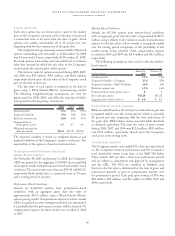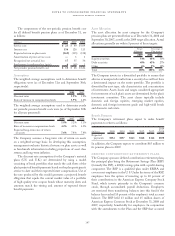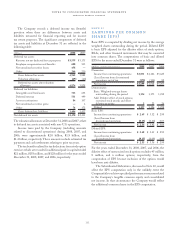American Express 2008 Annual Report Download - page 104
Download and view the complete annual report
Please find page 104 of the 2008 American Express annual report below. You can navigate through the pages in the report by either clicking on the pages listed below, or by using the keyword search tool below to find specific information within the annual report.
notes to consolidated financial statements
american express company
102
exposure to airline industry
The Company has multiple co-brand relationships and rewards
partners, of which airlines are one of the most important and
valuable. The Company’s largest airline co-brand partner
is Delta Air Lines (Delta), which merged with Northwest
Airlines on October 29, 2008. On December 9, 2008, the
Company announced that it had agreed to a 7-year extension
of its exclusive co-brand credit card partnerships with Delta, as
well as other partnership arrangements, including Membership
Rewards, merchant acceptance and travel. American Express’
Delta SkyMiles Credit Card co-brand portfolio accounts for
approximately 5 percent of the Company’s worldwide billed
business and less than 15 percent of worldwide cardmember
lending receivables.
In 2008, there were a significant number of airline
bankruptcies and liquidations, driven in part by volatile fuel
costs and weakening economies around the world. Historically,
the Company has not experienced significant revenue declines
when a particular airline scales back or ceases operations due
to a bankruptcy or other financial challenges. This is because
volumes generated by that airline are typically shifted to other
participants in the industry that accept the Company’s card
products. Nonetheless, the Company is exposed to business
and credit risk in the airline industry primarily through
business arrangements where the Company has remitted
payment to the airline for a cardmember purchase of tickets
that have not yet been used or “flown.” In the event that the
cardmember is not able to use the ticket and the Company,
based on the facts and circumstances, credits the cardmember
for the unused ticket, this business arrangement creates a
potential exposure for the Company. This credit exposure
is included in the maximum amount of undiscounted
future payments disclosed in Note 15 to the Company’s
Consolidated Financial Statements. Historically, even for an
airline that is operating under bankruptcy protection, this
type of exposure usually does not generate any significant
losses for the Company because an airline operating under
bankruptcy protection needs to continue accepting credit and
charge cards and honoring requests for credits and refunds in
the ordinary course of its business. Typically, as an airline’s
financial situation deteriorates, the Company delays payment
to the airline thereby increasing cash withheld to protect the
Company in the event the airline is liquidated. The Company’s
goal in these distressed situations is to hold sufficient cash
over time to ensure that upon liquidation, the cash held is
equivalent to the credit exposure related to any unused tickets.
The Company has not to date experienced significant losses
from airlines that have ceased operations and entered into
liquidation proceedings.
The current environment poses heightened challenges to the
Company’s ability to manage the airline risk, as more airlines
are converting their bankruptcy restructurings into liquidations
or, in some instances, moving directly to liquidation thereby
giving the Company less time to cover the Company’s exposure.
In addition, possible mergers, acquisitions and asset divestitures
in the airline industry may affect co-brand and Membership
Rewards relationships with involved airlines.
note 19
stock plans
stock option and award programs
Under the 2007 Incentive Compensation Plan and previously
under the 1998 Incentive Compensation Plan (the Plans),
awards may be granted to employees and other key individuals
who perform services for the Company and its participating
subsidiaries. These awards may be in the form of stock options,
restricted stock awards or units (RSAs), portfolio grants (PGs),
and similar awards designed to meet the requirements of non-
U.S. jurisdictions.
For the Company’s Plans, there were a total of 45 million,
52 million, and 66 million common shares unissued and
available for grant at December 31, 2008, 2007 and 2006,
respectively, as authorized by the Company’s Board of Directors
and shareholders.
The Company granted stock option awards to its Chief
Executive Officer (CEO) in November 2007 and January 2008
that have performance-based and market-based conditions.
These option awards are separately described below and are
excluded from the information and tables presented in the
following paragraphs.
A summary of stock option and RSA activity as of
December 31, 2008, and changes during the year are presented
below:
(Shares in thousands) Stock Options RSAs
Shares
Weighted
Average
Exercise
Price Shares
Weighted
Average
Grant
Price
Outstanding at
December 31, 2007 85,206 $39.93 7,523 $52.38
Granted 6,896 $47.73 3,292 $48.29
Exercised/vested (6,013) $32.21 (2,952) $49.66
Forfeited/expired (2,415) $43.98 (755) $51.00
Outstanding at
December 31, 2008(a) 83,674 $40.94 7,108 $51.49
Options exercisable at
December 31, 2008(a) 67,081 $38.20
(a) At December 31, 2008, the exercise prices for both stock options outstanding
and stock options exercisable ranged from $24.66 to $60.95.
























